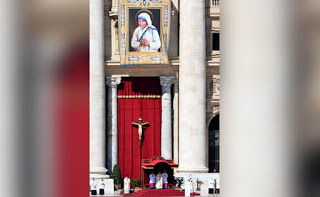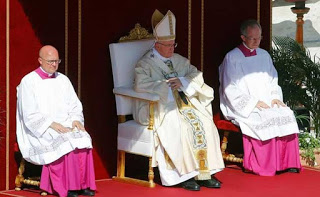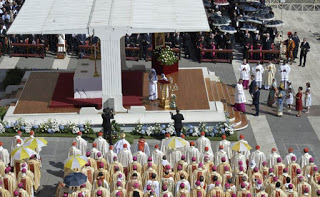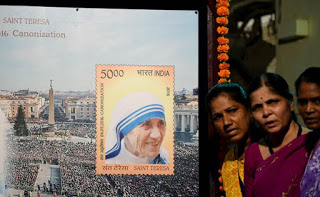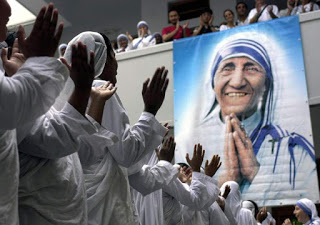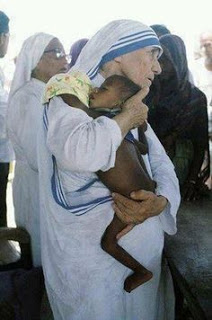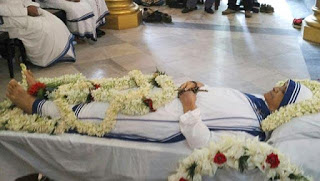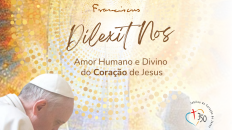CATHOLIC CHURCH ENROLLS MOTHER TERESA OF CALCUTTA IN
THE CANON OF SAINTS TODAY (04-09-2016); MATTERS ARISING:
THE CANON OF SAINTS TODAY (04-09-2016); MATTERS ARISING:
WHAT IS A SAINT
CANONIZATION OF SAINTS
IN THE CATHOLIC CHURCH AND INTERCESSION
IN THE CATHOLIC CHURCH AND INTERCESSION
BRIEF BIOGRAPHY OF
MOTHER TERESA OF CALCUTTA AND HER JOURNEY TO SAINTHOOD (1910-1997)
MOTHER TERESA OF CALCUTTA AND HER JOURNEY TO SAINTHOOD (1910-1997)
SAINT MAKING PROCESS
HER CANONIZATION TODAY
Following the canonization of India’s Mother Teresa of
Calcutta today at the Vatican with the gathering of half a million crowd, many
questions rented and is still renting the air (on the social media) ranging
from Catholics to non-Catholics. These I am going to treat under the sections
above as soon as possible. To begin with, what is a saint?
Calcutta today at the Vatican with the gathering of half a million crowd, many
questions rented and is still renting the air (on the social media) ranging
from Catholics to non-Catholics. These I am going to treat under the sections
above as soon as possible. To begin with, what is a saint?
· WHAT IS A SAINT
Saints, broadly speaking,
are all people who follow Jesus Christ and live their lives according to His
teaching. Catholics, however, also use the term more narrowly to refer to
especially holy men and women who, by persevering in the Christian Faith and living
extraordinary lives of virtue, have already entered Heaven. The word “saint” comes from the
Latin “sanctus” and literally means
“holy.” Throughout the New Testament, saint is used to refer to all
who believe in Jesus Christ and who followed His teachings. Saint Paul
often addresses his epistles to “the saints” of a particular
city (see, for instance, Ephesians 1:1 and2 Corinthians 1:1).
With time, it became clear
that some Christians lived lives of extraordinary, or heroic, virtue, beyond
that of the average Christian believer. While other Christians struggled to
live out the gospel of Christ, these particular Christians were eminent
examples of the moral virtues (or cardinal virtues), and they practiced the theological virtues of faith, hope, and charity and exhibited the gifts of the Holy Spirit in
their lives. Consequently, the word saint,
previously applied to all Christian believers, became more narrowly
applied to such people, with the belief that they are being rewarded in heaven,
as such they were venerated after their deaths as saints, usually by the
members of their local church or the Christians in the region where they had
lived, because they were familiar with their good deeds.
are all people who follow Jesus Christ and live their lives according to His
teaching. Catholics, however, also use the term more narrowly to refer to
especially holy men and women who, by persevering in the Christian Faith and living
extraordinary lives of virtue, have already entered Heaven. The word “saint” comes from the
Latin “sanctus” and literally means
“holy.” Throughout the New Testament, saint is used to refer to all
who believe in Jesus Christ and who followed His teachings. Saint Paul
often addresses his epistles to “the saints” of a particular
city (see, for instance, Ephesians 1:1 and2 Corinthians 1:1).
With time, it became clear
that some Christians lived lives of extraordinary, or heroic, virtue, beyond
that of the average Christian believer. While other Christians struggled to
live out the gospel of Christ, these particular Christians were eminent
examples of the moral virtues (or cardinal virtues), and they practiced the theological virtues of faith, hope, and charity and exhibited the gifts of the Holy Spirit in
their lives. Consequently, the word saint,
previously applied to all Christian believers, became more narrowly
applied to such people, with the belief that they are being rewarded in heaven,
as such they were venerated after their deaths as saints, usually by the
members of their local church or the Christians in the region where they had
lived, because they were familiar with their good deeds.
· CANONIZATION AND INTERCESSION OF
SAINTS
SAINTS
Eventually, the Catholic
Church created a process, called canonization,
through which such venerable people could be recognized as saints by all
Christians everywhere. The Roman
Catholic Church has more than 10,000 canonized saints However, there are many other holy men
and women “elsewhere” who did the will of God and have gone to heaven after
their death but are not being recognized or enrolled in the canon of saints;
this does not mean that they are not saints. The Catholic Church has a day to
honour and remember such people for the good lives they led. This is called
“All Saints Day” (celebrated every 1st day of November). Enrolling a saint
into the Canon makes the saint a model, leading souls to Christ, the grand
model.
Church created a process, called canonization,
through which such venerable people could be recognized as saints by all
Christians everywhere. The Roman
Catholic Church has more than 10,000 canonized saints However, there are many other holy men
and women “elsewhere” who did the will of God and have gone to heaven after
their death but are not being recognized or enrolled in the canon of saints;
this does not mean that they are not saints. The Catholic Church has a day to
honour and remember such people for the good lives they led. This is called
“All Saints Day” (celebrated every 1st day of November). Enrolling a saint
into the Canon makes the saint a model, leading souls to Christ, the grand
model.
Honouring the saints has a
biblical root. In the letter to the Hebrews 13:7, the author expresses: “Remember your leaders, those who spoke the word of
God to you. Consider the outcome of their way of life and imitate their faith.”
This is basically the reason for honouring our brothers and sisters who led
holy lives and have gone to heaven, so that by imitating their ways of life,
some day we shall also be with them in heaven. Some people might ask: “Can the
saints in heaven hear us? Why
honouring them, they have died and no more alive”etc.. To this effect, I want
to quickly point out that; to the world, the saints (those who have died) appeared
to be dead, but the Scripture made us to realize that they are not dead. In
Luke’s gospel, Jesus said: “I say unto you, that likewise
joy shall be in heaven over one sinner that repents, more than over ninety and
nine just persons, which need no repentance” (Luke 15:7) and “Likewise, I say unto you, there
is joy in the presence of the angels of God over one sinner that repents”
(Luke 15:10). This shows that those who have died in Christ are not dead but
alive in heaven and know what happens on earth.
biblical root. In the letter to the Hebrews 13:7, the author expresses: “Remember your leaders, those who spoke the word of
God to you. Consider the outcome of their way of life and imitate their faith.”
This is basically the reason for honouring our brothers and sisters who led
holy lives and have gone to heaven, so that by imitating their ways of life,
some day we shall also be with them in heaven. Some people might ask: “Can the
saints in heaven hear us? Why
honouring them, they have died and no more alive”etc.. To this effect, I want
to quickly point out that; to the world, the saints (those who have died) appeared
to be dead, but the Scripture made us to realize that they are not dead. In
Luke’s gospel, Jesus said: “I say unto you, that likewise
joy shall be in heaven over one sinner that repents, more than over ninety and
nine just persons, which need no repentance” (Luke 15:7) and “Likewise, I say unto you, there
is joy in the presence of the angels of God over one sinner that repents”
(Luke 15:10). This shows that those who have died in Christ are not dead but
alive in heaven and know what happens on earth.
The saints are not dead, they
are alive. Jesus says that “God is not the God of the dead, but of
the living” (Matthew 22:32). The letter to the Hebrews says that we
are surrounded by a cloud of witnesses, in Hebrews 12:1. Witnesses have
to be alive in order to testify on our behalf to the supreme judge. In
Revelation 6:10, we learn that the saints in heaven know what is going on down
here on earth. People who believe that being dead in the body is
also dead in the soul are called atheists, not Christians. It would be sinful
to conjure up a dead person, like Saul did with Samuel (1 Samuel 28:14), in
order to gain hidden knowledge (Deuteronomy 18:10-12). But asking
for intercession (1 Timothy 2:1) from holy people is very biblical, due to the
power they have (James 5:16). Revelation 5:8 and 8:3 plainly state that the
saints and angels present our prayers to God in the form of incense. Saints pray alongside with us to
Jesus as our intercessors. They do not stand “between” us and God. They
only pray with us and for us to Jesus who is the MEDIATOR and the WAY. This can be seen, for example, in Revelation 5:8,
where John depicts the saints in heaven offering our prayers to God under the
form of “golden bowls full of incense, which are the prayers of the
saints.” But if the saints in heaven are offering our prayers to God, then
they must be aware of our prayers. They are aware of our petitions and present
them to God by interceding for us.
are alive. Jesus says that “God is not the God of the dead, but of
the living” (Matthew 22:32). The letter to the Hebrews says that we
are surrounded by a cloud of witnesses, in Hebrews 12:1. Witnesses have
to be alive in order to testify on our behalf to the supreme judge. In
Revelation 6:10, we learn that the saints in heaven know what is going on down
here on earth. People who believe that being dead in the body is
also dead in the soul are called atheists, not Christians. It would be sinful
to conjure up a dead person, like Saul did with Samuel (1 Samuel 28:14), in
order to gain hidden knowledge (Deuteronomy 18:10-12). But asking
for intercession (1 Timothy 2:1) from holy people is very biblical, due to the
power they have (James 5:16). Revelation 5:8 and 8:3 plainly state that the
saints and angels present our prayers to God in the form of incense. Saints pray alongside with us to
Jesus as our intercessors. They do not stand “between” us and God. They
only pray with us and for us to Jesus who is the MEDIATOR and the WAY. This can be seen, for example, in Revelation 5:8,
where John depicts the saints in heaven offering our prayers to God under the
form of “golden bowls full of incense, which are the prayers of the
saints.” But if the saints in heaven are offering our prayers to God, then
they must be aware of our prayers. They are aware of our petitions and present
them to God by interceding for us.
Having said this, we return to the heart of our discussion: “THE CANONIZATION OF MOTHER TERESA
OF CALCUTTA”. Who really is this woman and why is she being honoured today
as a saint?
OF CALCUTTA”. Who really is this woman and why is she being honoured today
as a saint?
· BIOGRAPHY (BRIEF)
Mother Teresa of Calcutta, also known as
the “saint of the gutters” was born as Agnes Gonxha Bojaxhiu was born on 26 August 1910, in Skopje,
Macedonia, to Albanian heritage. After spending her adolescence under her
devoted and pious mother (her father died when she was barely 8years old) and
deeply involved in parish activities, Agnes left home in September 1928, for
the Loreto Convent in Rathfarnam (Dublin), Ireland, where she was admitted as a
postulant on October 12 and received the name of Teresa, after her patroness,
St. Therese of Lisieux. Agnes was sent by the Loreto order to India and
arrived in Calcutta on 6 January 1929. Upon her arrival, she joined the Loreto
novitiate in Darjeeling. She made her final profession as a Loreto nun on 24
May 1937, and hereafter was called Mother Teresa. Mother Teresa taught in India
for 17 years before she experienced her 1946 “call within a call” to
devote herself to caring for the sick and poor. Her order established a
hospice; centers for the blind, aged, and disabled; and a leper colony. In 1979
she received the Nobel Peace Prize for her humanitarian work. Throughout
the 1950s and early 1960s, Mother Teresa expanded the work of the Missionaries
of Charity both within Calcutta and throughout India. On 1 February 1965, Pope
Paul VI granted the Decree of Praise to the Congregation, raising it to
pontifical right. The first foundation outside India opened in Cocorote,
Venezuela, in 1965. The Society expanded to Europe (the Tor Fiscale suburb of
Rome) and Africa (Tabora, Tanzania) in 1968. Mother Teresa spoke at the fortieth anniversary of the
United Nations General Assembly in October 1985. On Christmas Eve of that year,
Mother Teresa opened “Gift of Love” in New York, her first house for
AIDS patients. In the coming years, this home would be followed by others, in
the United States and elsewhere, devoted specifically for those with AIDS. After a summer of travelling to Rome,
New York, and Washington, in a weak state of health, Mother Teresa returned to
Calcutta in July 1997. At 9:30 PM, on 5 September, Mother Teresa died at the
Motherhouse. Her body was transferred to St Thomas’s Church, next to the Loreto
convent where she had first arrived nearly 69 years earlier. Hundreds of
thousands of people from all classes and all religions, from India and abroad,
paid their respects. She received a state funeral on 13 September, her body
being taken in procession – on a gun carriage that had also borne the bodies of
Mohandas K. Gandhi and Jawaharlal Nehru – through the streets of Calcutta.
Presidents, prime ministers, queens, and special envoys were present on behalf
of countries from all over the world.
the “saint of the gutters” was born as Agnes Gonxha Bojaxhiu was born on 26 August 1910, in Skopje,
Macedonia, to Albanian heritage. After spending her adolescence under her
devoted and pious mother (her father died when she was barely 8years old) and
deeply involved in parish activities, Agnes left home in September 1928, for
the Loreto Convent in Rathfarnam (Dublin), Ireland, where she was admitted as a
postulant on October 12 and received the name of Teresa, after her patroness,
St. Therese of Lisieux. Agnes was sent by the Loreto order to India and
arrived in Calcutta on 6 January 1929. Upon her arrival, she joined the Loreto
novitiate in Darjeeling. She made her final profession as a Loreto nun on 24
May 1937, and hereafter was called Mother Teresa. Mother Teresa taught in India
for 17 years before she experienced her 1946 “call within a call” to
devote herself to caring for the sick and poor. Her order established a
hospice; centers for the blind, aged, and disabled; and a leper colony. In 1979
she received the Nobel Peace Prize for her humanitarian work. Throughout
the 1950s and early 1960s, Mother Teresa expanded the work of the Missionaries
of Charity both within Calcutta and throughout India. On 1 February 1965, Pope
Paul VI granted the Decree of Praise to the Congregation, raising it to
pontifical right. The first foundation outside India opened in Cocorote,
Venezuela, in 1965. The Society expanded to Europe (the Tor Fiscale suburb of
Rome) and Africa (Tabora, Tanzania) in 1968. Mother Teresa spoke at the fortieth anniversary of the
United Nations General Assembly in October 1985. On Christmas Eve of that year,
Mother Teresa opened “Gift of Love” in New York, her first house for
AIDS patients. In the coming years, this home would be followed by others, in
the United States and elsewhere, devoted specifically for those with AIDS. After a summer of travelling to Rome,
New York, and Washington, in a weak state of health, Mother Teresa returned to
Calcutta in July 1997. At 9:30 PM, on 5 September, Mother Teresa died at the
Motherhouse. Her body was transferred to St Thomas’s Church, next to the Loreto
convent where she had first arrived nearly 69 years earlier. Hundreds of
thousands of people from all classes and all religions, from India and abroad,
paid their respects. She received a state funeral on 13 September, her body
being taken in procession – on a gun carriage that had also borne the bodies of
Mohandas K. Gandhi and Jawaharlal Nehru – through the streets of Calcutta.
Presidents, prime ministers, queens, and special envoys were present on behalf
of countries from all over the world.
SAINT MAKING PROCESS (CANONIZATION)
The process of canonization can begin 5-50 years after the
death of the candidate. In 1999, Pope John Paul II waived the normal five-year
waiting period, clearing Mother Teresa for immediate consideration for
canonization because she was considered a “living saint”. Once the
process begins, the person is called a “Servant of God”.
death of the candidate. In 1999, Pope John Paul II waived the normal five-year
waiting period, clearing Mother Teresa for immediate consideration for
canonization because she was considered a “living saint”. Once the
process begins, the person is called a “Servant of God”.
The next phase — Postulation — has to do with gathering
testimony, public and private writings, and getting them examined, and has to
be established by the Diocese. This phase takes long, sometimes many years, and
ends with the judgment of a Diocesan tribunal, in which the Bishop takes a
decision on the candidate’s exceptional virtue and dedication to God. If
permission is granted, the Bishop’s report goes to Rome, where it is translated
into Italian — this step is called the Apostolic Process. A summary is then
presented to the Congregation for the Causes of Saints, where 9 theologians
scrutinize the evidence and documentation. If a majority passes it, it goes to
the Pope; once recognized by the Pontiff, the candidate is called Venerable.
testimony, public and private writings, and getting them examined, and has to
be established by the Diocese. This phase takes long, sometimes many years, and
ends with the judgment of a Diocesan tribunal, in which the Bishop takes a
decision on the candidate’s exceptional virtue and dedication to God. If
permission is granted, the Bishop’s report goes to Rome, where it is translated
into Italian — this step is called the Apostolic Process. A summary is then
presented to the Congregation for the Causes of Saints, where 9 theologians
scrutinize the evidence and documentation. If a majority passes it, it goes to
the Pope; once recognized by the Pontiff, the candidate is called Venerable.
The next step is Beatification. For a person to be declared
Blessed there has to be approval of a “miracle”, which is evidence of the
intercessory power of the Venerable Servant of God, an indication that he or
she has united with God after death. The Diocese where the so-called miracle is
claimed to have taken place carries out a scientific and theological
investigation. The Scientific Commission must decide by accepted scientific
criteria that there is no natural explanation for the alleged miracle, and the
Theological Commission will judge whether what happened was indeed a “miracle”,
and whether it was due to the intercession of the Venerable Servant of God. If
the Commissions turn in positive findings, the findings go to the Pope — and if
he approves, the candidate is beatified. In the case of martyrdom, the
requirement of a miracle is waived. The first one, which led to Mother Teresa’s
beatification in 2003, was of a Bengali tribeswoman Monica Besra, who was
‘cured’ from an abdominal tumour due to Mother Teresa’s intervention; the
report in “The Mirror journal” explains. A commission from the Vatican judged
the woman’s recovery was down to a locket containing a picture of the Mother
Teresa which was placed on the patient’s stomach.
Blessed there has to be approval of a “miracle”, which is evidence of the
intercessory power of the Venerable Servant of God, an indication that he or
she has united with God after death. The Diocese where the so-called miracle is
claimed to have taken place carries out a scientific and theological
investigation. The Scientific Commission must decide by accepted scientific
criteria that there is no natural explanation for the alleged miracle, and the
Theological Commission will judge whether what happened was indeed a “miracle”,
and whether it was due to the intercession of the Venerable Servant of God. If
the Commissions turn in positive findings, the findings go to the Pope — and if
he approves, the candidate is beatified. In the case of martyrdom, the
requirement of a miracle is waived. The first one, which led to Mother Teresa’s
beatification in 2003, was of a Bengali tribeswoman Monica Besra, who was
‘cured’ from an abdominal tumour due to Mother Teresa’s intervention; the
report in “The Mirror journal” explains. A commission from the Vatican judged
the woman’s recovery was down to a locket containing a picture of the Mother
Teresa which was placed on the patient’s stomach.
To take the process forward towards canonization, however,
a second miracle is needed. The same procedure is followed, and ends with the
Pope’s decision, which is considered to be protected from error by the Holy
Spirit. Mother Teresa’s second miracle was associated to a Brazilian
man Marcilio Haddad Andrino, who was in a coma in 2008, because of a viral
brain infection. “The Times of
India reported: “Scheduled to undergo surgery at a hospital in Santos,
Andrino was fighting for his life. On the eve of the operation, his wife
Fernanda Rocha walked into the room of Father Elmiran Ferreira of the Parish of
Our Lady of Aparecida in Sao Vincente and asked for help. The Catholic priest
gave Fernanda a medal and prayer of Mother Teresa and asked to pray to the
Kolkata nun. The next morning, so goes the official story, Andrino was sitting
on his bed. All his symptoms were gone”. Today, the couple along with
their children attended the canonization ceremony in Rome.
a second miracle is needed. The same procedure is followed, and ends with the
Pope’s decision, which is considered to be protected from error by the Holy
Spirit. Mother Teresa’s second miracle was associated to a Brazilian
man Marcilio Haddad Andrino, who was in a coma in 2008, because of a viral
brain infection. “The Times of
India reported: “Scheduled to undergo surgery at a hospital in Santos,
Andrino was fighting for his life. On the eve of the operation, his wife
Fernanda Rocha walked into the room of Father Elmiran Ferreira of the Parish of
Our Lady of Aparecida in Sao Vincente and asked for help. The Catholic priest
gave Fernanda a medal and prayer of Mother Teresa and asked to pray to the
Kolkata nun. The next morning, so goes the official story, Andrino was sitting
on his bed. All his symptoms were gone”. Today, the couple along with
their children attended the canonization ceremony in Rome.
·
THE CANONIZATION TODAY
THE CANONIZATION TODAY
Today, she is been canonized and honoured as a saint by the
gathering of thousands at the Vatican with the celebration of the Holy Mass.
The Mass just ended some minutes ago. Pope
Francis praised Mother Teresa as the merciful saint who defended the lives of
the unborn, sick and abandoned – and who shamed world leaders for the
“crimes of poverty they themselves created.” Speaking from the steps
of St Peter’s Basilica, Pope Francis said St Teresa, “made her voice heard
before the powers of the world, so that they might recognize their guilt for
the crimes of poverty they themselves created.” As if to emphasize the
point, Francis repeated the “the crimes of poverty they themselves
created.” Her legacy
complements Pope Francis’s vision of a humble church that strives to serve the
poor, and the festivities are a highlight of his Holy Year of Mercy, which runs
until November 8.
gathering of thousands at the Vatican with the celebration of the Holy Mass.
The Mass just ended some minutes ago. Pope
Francis praised Mother Teresa as the merciful saint who defended the lives of
the unborn, sick and abandoned – and who shamed world leaders for the
“crimes of poverty they themselves created.” Speaking from the steps
of St Peter’s Basilica, Pope Francis said St Teresa, “made her voice heard
before the powers of the world, so that they might recognize their guilt for
the crimes of poverty they themselves created.” As if to emphasize the
point, Francis repeated the “the crimes of poverty they themselves
created.” Her legacy
complements Pope Francis’s vision of a humble church that strives to serve the
poor, and the festivities are a highlight of his Holy Year of Mercy, which runs
until November 8.
While alive, she was noted to have said: “By blood, I am Albanian. By
citizenship, an Indian. By faith, I am a Catholic nun. As to my calling, I
belong to the world. As to my heart, I belong entirely to the Heart of
Jesus”. Small of stature, rocklike in faith, Mother Teresa of Calcutta
was entrusted with the mission of proclaiming God’s thirsting love for
humanity, especially for the poorest of the poor. She says: “God
still loves the world and He sends you and me to be His love and His compassion
to the poor.” She was a soul filled with the light of Christ, on fire
with love for Him and burning with one desire: “to
quench His thirst for love and for souls.”
citizenship, an Indian. By faith, I am a Catholic nun. As to my calling, I
belong to the world. As to my heart, I belong entirely to the Heart of
Jesus”. Small of stature, rocklike in faith, Mother Teresa of Calcutta
was entrusted with the mission of proclaiming God’s thirsting love for
humanity, especially for the poorest of the poor. She says: “God
still loves the world and He sends you and me to be His love and His compassion
to the poor.” She was a soul filled with the light of Christ, on fire
with love for Him and burning with one desire: “to
quench His thirst for love and for souls.”
As we celebrate her canonization today, may we imitate her faith and her examples in bearing witness and living out the gospel values… “For when I was hungry, you gave me to eat, when I was naked, you clothed me, when I was sick, you visited me…” (Mtt. 25:35ff)
PHOTO SPEAKS AT THE CANONIZATION IN THE VATICAN
Saint Teresa of Calcutta; pray with and
for us.
for us.
Happy Feast-day to you all!!!
CLICK HERE TO ALSO READ: “ASKING THE SAINTS TO PRAY FOR US… “FROM THE SCRIPTURAL PERSPECTIVE”

